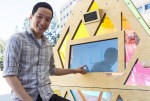Students crowded around a mysterious Space Age box with neon lights and sharp angular edges. The strange futuristic shape stood out against UCLA’s brick architecture, attracting students on their daily walks to class.
Along with bright lights and large display screens, students discovered a futuristic exhibit about representation in Hollywood movies and television.
Last week, UCLA’s Marketing and Special Events department unveiled the new interactive “pop-up” exhibit which highlights some findings from director of the Bunche Centre for African American studies and sociology professor Darnell Hunt, assistant director and associate researcher of the Bunche Centre for African American studies Ana-Christina Ramon and graduate student Michael Tran’s 2016 edition of the Hollywood Diversity Report. The report has reported statistical data on race and gender representation in Hollywood since 2014.
The angular sculpture, reminiscent of an extraterrestrial spacecraft or high-tech robot, has been on display outside Powell, Bunche and Covel since March 27 and will continue inside the Kerckhoff Art Gallery until April 6.
Eric Greene, assistant communications director at UCLA, said the goal of the exhibit is to prompt students to think about why issues of representation matter. The strange shape of the exhibit is reminiscent of a molecule, Greene said, to highlight the fundamental connection between all people.
“I think its good for the entire UCLA community … to be really critically aware of the culture that we consume,” Greene said. “Getting information out to people that’s going to challenge the assumptions that people already have is part of the mission of this project.”
Sitting at one of the exhibit’s four screens, users can interact with a large touchscreen display showing a colorful orb, which rotates around questions about representation like “If you could change the race of your favorite superhero, would you?” and “Can you see yourself in your favorite comedy?” With one tap, users can input their perspectives on the issue and look at data about each question.
The display is also programmed with graphs and figures that help illustrate the results of the study. Colorful pie charts and blue and red mountain shapes appear on the screen, providing viewers with information on representation in comedy shows or leading box office movies.
Tran said the display helps students relate to the dense research findings of the Hollywood Diversity Report, which boasts over 50 pages of statistical information.
“When I first saw the concept art, I thought, ‘This is amazing,’” Tran said. “The report is written in a way that’s meant to be clearly objective … what I love about the (exhibit) is that it has this humanistic appeal to it.”
Several users interact with the exhibit daily, tapping the screens under the shade of the exhibit’s white awning, among them first-year history student Vanessa Young.
Although Young said some of the graphs were more instructive than others, she enjoyed interacting with the display and learning about representation in Hollywood.
“I think (the exhibit) is important to remind students about the issue,” Young said.
Student engagement with the material is important, Hunt said, because the world students live in is getting more and more diverse. The disconnect between Hollywood and the society it is supposed to represent creates problems of inclusion and equity, Hunt said.
In the future, Greene said the exhibit will display other UCLA researchers’ findings after it finishes showing the results from the Hollywood Diversity Report.
“We felt the students in particular would find the findings of this particular report useful,” Hunt said. “We just feel it’s an important issue that any community like UCLA needs to be aware of and engage with.”
